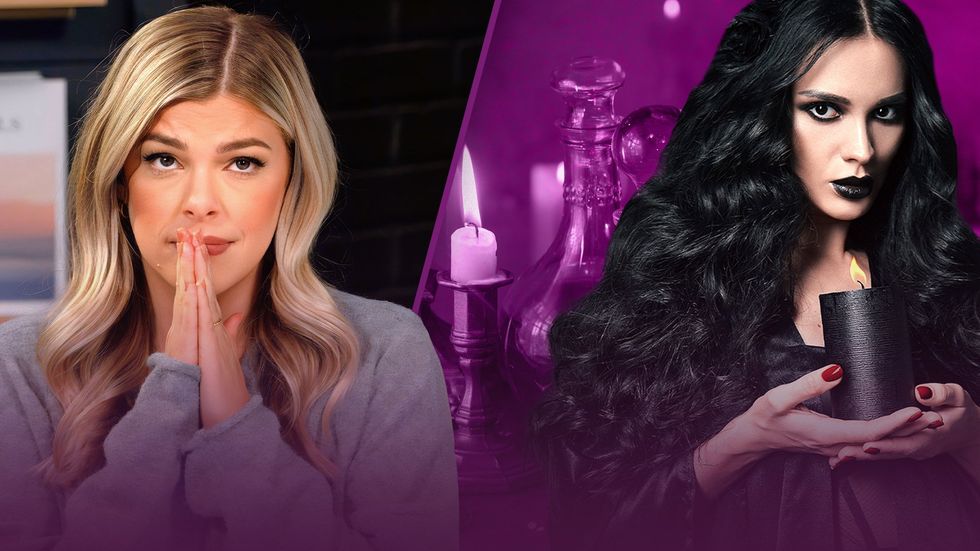The dark arts have a new name — witchcore — and it's lurking in your local grocery store
Paganism has been on the rise in the Western world for some time now. More and more people are abandoning their religious upbringings and rejecting the Judeo-Christian values of the West. While some have opted to adopt agnosticism or atheism, others, especially Gen Zers, have chosen to replace Christianity with a different set of beliefs and practices rooted in paganism. Ranging from engaging in actual black magic to just dressing in dark, edgy clothing, witchcore is the newest fad among the rising generation. Unlike the colonial days when witches were so feared that even the town spinster had to watch her back, today, witches and witchcraft are embraced by society. Allie Beth Stuckey points to a recent magazine in a grocery store checkout lane titled “Witches: Discover their secretive and mysterious practices” as an example of how mainstream the occult has become. The magazine, which features a woman clad in black robes and a pointed hat holding a cluster of burning red candles, sits adjacent to gossip columns and rows of candy as if it’s just another mundane object. “This is clearly a glorification of witchcraft,” says Allie. While the magazine features a traditional-looking witch, the majority of today’s witches look like “your normal suburban mom.” “Even if someone is not wearing a pointy hat and walking around with their black cat, they might be imbibing and emulating [and] exhibiting aspects of witchcraft,” says Allie. Further, modern “witchcraft doesn't necessarily always look like a Ouija board or like dying your hair black and casting spells,” she explains. It often looks like “manifesting,” “transcendental meditation,” “burning sage,” “using crystals,” etc. Modern witches weren’t ushered into the dark arts because they happened to stumble upon a group of women chanting incantations in the forest either. Most of them were introduced to new age concepts in the growing realm of “self-help” and “self-empowerment” guides. Allie explains that things like “a Cosmo article,” “astrology,” or the idea of tapping into your inner “goddess” is all it takes for someone to set off down a path of darkness. A recent British Vogue article even spoke on the subject of witchcore and admitted that although the fad aims to “merge romantic mystical vibes with grungy Gothic undertones,” the “witchcore aesthetic is influenced by ancient rituals and practices, from potion making and herbalism to tarot card reading, sage burning, and crystal healing.” “It’s not just about following a trend that you saw that you think is cute,” says Allie. Even things that seem benign, like a specific clothing aesthetic, are rooted in the incredibly dark idea of unleashing “a woman’s darker side.” Artists like Taylor Swift are heavily responsible for viralizing the witchcore trend. Allie plays a video of Swift performing on her Eras tour in a black robe surrounded by a circle of female dancers who are also clad in black robes. They essentially bow down to the pop icon who stands in the center of the dark ring. “That is clearly demonic,” says Allie. What’s perhaps even more disturbing, however, is the number of Christians who don’t recognize that these new age concepts and practices are satanic in nature. Some even try to engage in certain aspects of new ageism while maintaining their Christian faith. “That’s called syncretism,” says Allie. “In the Book of Revelation, one of the things that [Jesus] condemns is syncretism — trying to wed light and darkness.” To hear more of Allie’s commentary on the rise of modern witchcraft, watch the episode above. Want more from Allie Beth Stuckey?To enjoy more of Allie’s upbeat and in-depth coverage of culture, news, and theology from a Christian, conservative perspective, subscribe to BlazeTV — the largest multi-platform network of voices who love America, defend the Constitution, and live the American dream.


Paganism has been on the rise in the Western world for some time now. More and more people are abandoning their religious upbringings and rejecting the Judeo-Christian values of the West. While some have opted to adopt agnosticism or atheism, others, especially Gen Zers, have chosen to replace Christianity with a different set of beliefs and practices rooted in paganism. Ranging from engaging in actual black magic to just dressing in dark, edgy clothing, witchcore is the newest fad among the rising generation.
Unlike the colonial days when witches were so feared that even the town spinster had to watch her back, today, witches and witchcraft are embraced by society.
Allie Beth Stuckey points to a recent magazine in a grocery store checkout lane titled “Witches: Discover their secretive and mysterious practices” as an example of how mainstream the occult has become. The magazine, which features a woman clad in black robes and a pointed hat holding a cluster of burning red candles, sits adjacent to gossip columns and rows of candy as if it’s just another mundane object.
“This is clearly a glorification of witchcraft,” says Allie.
While the magazine features a traditional-looking witch, the majority of today’s witches look like “your normal suburban mom.”
“Even if someone is not wearing a pointy hat and walking around with their black cat, they might be imbibing and emulating [and] exhibiting aspects of witchcraft,” says Allie.
Further, modern “witchcraft doesn't necessarily always look like a Ouija board or like dying your hair black and casting spells,” she explains. It often looks like “manifesting,” “transcendental meditation,” “burning sage,” “using crystals,” etc.
Modern witches weren’t ushered into the dark arts because they happened to stumble upon a group of women chanting incantations in the forest either. Most of them were introduced to new age concepts in the growing realm of “self-help” and “self-empowerment” guides. Allie explains that things like “a Cosmo article,” “astrology,” or the idea of tapping into your inner “goddess” is all it takes for someone to set off down a path of darkness.
A recent British Vogue article even spoke on the subject of witchcore and admitted that although the fad aims to “merge romantic mystical vibes with grungy Gothic undertones,” the “witchcore aesthetic is influenced by ancient rituals and practices, from potion making and herbalism to tarot card reading, sage burning, and crystal healing.”
“It’s not just about following a trend that you saw that you think is cute,” says Allie. Even things that seem benign, like a specific clothing aesthetic, are rooted in the incredibly dark idea of unleashing “a woman’s darker side.”
Artists like Taylor Swift are heavily responsible for viralizing the witchcore trend.
Allie plays a video of Swift performing on her Eras tour in a black robe surrounded by a circle of female dancers who are also clad in black robes. They essentially bow down to the pop icon who stands in the center of the dark ring.
“That is clearly demonic,” says Allie.
What’s perhaps even more disturbing, however, is the number of Christians who don’t recognize that these new age concepts and practices are satanic in nature. Some even try to engage in certain aspects of new ageism while maintaining their Christian faith.
“That’s called syncretism,” says Allie.
“In the Book of Revelation, one of the things that [Jesus] condemns is syncretism — trying to wed light and darkness.”
To hear more of Allie’s commentary on the rise of modern witchcraft, watch the episode above.
Want more from Allie Beth Stuckey?
To enjoy more of Allie’s upbeat and in-depth coverage of culture, news, and theology from a Christian, conservative perspective, subscribe to BlazeTV — the largest multi-platform network of voices who love America, defend the Constitution, and live the American dream.
Originally Published at Daily Wire, World Net Daily, or The Blaze
What's Your Reaction?

































































































